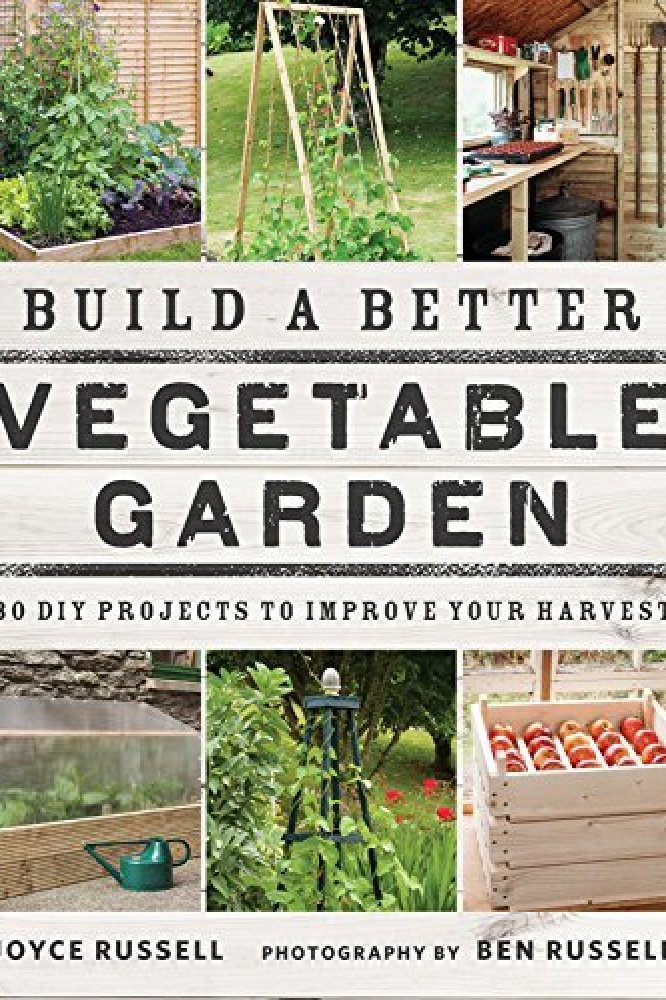Extract p60-63 - Build a Better Vegetable Garden by Joyce Russell and Ben Russell

Build a Better Vegetable Garden
Wooden Planter
Make your own planters using this simple technique to fill your garden and patio with fruit, vegetables and flowers. You can make different sizes to suit your space and then decide what to sow and grow.
You will need
For a 61cm x 25cm (24in x 10in) planter
• Timber
• 2 x 61cm x 15cm x 25mm (24in x 6in x 1in) sides
• 2 x 20cm x 15cm x 25mm (8in x 6in x 1in) ends
• 1 x 56cm x 15cm x 25mm (22in x 6in x 1in) base
• 2 x 18cm x 50mm x 25mm (7in x 2in x 1in) rails
• Screws
• 16 x 4mm x 40mm (No 8 x 11/2in) screws, stainless steel
TOOLS
• Tape measure
• Saw
• Ruler
• Pencil
• Screwdriver
• Sanding sheet
• Drill with 4mm (5/32in) and
10mm (3/8in) drill bits
There are lots of beautiful ceramic pots and large containers for sale and these look lovely when planted with a mix of flowers and edible crops. Planters can transform the front of a house or a small patio, creating a beautiful and practical miniature productive garden for very little effort.
Containers can be expensive, of course, but it is really very easy to make your own for much less. You won't require many tools, nor do you need to be a skilled craftsperson to follow this simple design, and you can make larger or smaller versions to suit specific plants. These wooden planters are made from durable larch and look great dotted among ceramic pots,
and because they cost so little you may decide to make a whole range to dress up your plot. They're ideal for growing salad leaves, herbs, peas, and strawberries, or any other compact crop that thrives in a confined space.
Making the wooden planter
STEP 1 PREPARE THE TIMBER
Cut timber to the lengths shown on the plan. Keep square ends for the simplest construction, or mark and cut the upright sides at an angle to make a broad wedge shape. Those shown here taper from 20cm (8in) at the top to 15cm (6in) at the base.
STEP 2 DRILL HOLES IN THE SIDES
For both sides, use a 4mm (5/32in) bit to make a clearance hole, 15cm (6in) from the end and 12mm (1/2in) from lower edge. Also make one clearance hole at each corner, 12mm (1/2in) from the end and 25mm (1in) from the top and bottom.
STEP 3 DRILL HOLES IN THE BASE
Use the 10mm (3/8in) drill bit to make 12 holes in the base, spaced evenly at about 30mm (13/4in) from the edges. These allow for drainage while not compromising the strength of the base. Sand rough edges and drill holes to remove splinters.
STEP 4 JOIN SIDE AND END PIECES
Lay the pieces out and check they will fit together exactly before assembling. Use 4mm x 40mm (No 8 x 11/2in) screws to fix the sides and ends; drive them through the holes drilled in the corners of the sides (see Step 2) and into the end pieces.
STEP 5 ATTACH THE BASE AND RAILS
Slot the base into the frame, so it is flush with the sides. Use two screws through the holes in the lower edges of the sides to fix the base in place. Use the 4 mm (5/32in) bit to make clearance holes in the rails. Screw rails in place across the base.
STEP 6 FILL WITH COMPOST
Turn the planter the right way up. It should stand level on the rails. Fill with compost or a mix of compost and well-rotted manure and water well, so the compost is damp enough to plant into. The rails will lift up the planter to allow free drainage.
EXPERT TIP
When fitting the planter together, remember the sides overlap the ends.
GROWING TIPS FOR WOODEN PLANTERS
You can use a stain or paint the planter, or leave the wood untreated, but if you want a natural look, use a durable wood such as larch, cedar or oak.
• Keep the planter near a house wall, which will provide a bit of extra warmth and some protection from wind.
• Remember to water your container regularly and don't let the compost dry out. Water every day in hot sunny weather.
• Compost will contain enough nutrients for roughly six weeks' of strong growth. After this time, use liquid feeds every week to ten days for large plants, or every two weeks for salad leaves.
• Peas grow well in this size of planter and will produce a surprising number of pods. Although tall varieties won't reach the heights of those grown in a garden bed, they will flower prolifically at a lower height. Put 12 plants in a planter of this size and push sticks in to support them as they start to climb.
• Sit the planter on a low patio wall and grow three strawberry plants. The fruit will tumble down the wall and you can pick and eat it while you sit in the sun.
• Sow rocket at any time of the year for a handy supply of this popular salad leaf. Keep plants watered and pick the leaves regularly so plants continue to produce more crops and don't bolt.
• Grow herbs by the kitchen door in your planter and you will only have to reach out to pick a few fresh leaves.
• Make larger planters for containerised fruit trees, or use them to grow a few salad potatoes, carrots, or beans. Also try flowering bulbs and bedding plants, or anything you like; just ensure you provide enough damp compost and nutrients to sustain good growth.
Build a Better Vegetable Garden by Joyce Russell, photography by Ben Russell, is published by Frances Lincoln (£16.99)

